89. How Walmart Optimized Inventory Management with AI: A Retail Case Study
Stock too little of what customers want, and shelves go empty – leading to lost sales and frustrated shoppers. Stock too much, and capital is tied up in surplus goods – leading to waste and markdowns. Achieving the perfect balance is exceedingly difficult, especially at the massive scale of a company like Walmart. In recent years, Walmart turned to a powerful ally to tackle this challenge: artificial intelligence (AI). This article explores how Walmart, the world’s largest retailer, successfully optimized its inventory management using AI-driven solutions. We’ll look at the company’s background, the problems it faced, the AI technologies implemented, and the impressive data-backed results. Key performance indicators (KPIs) will highlight the impact, and we’ll distill lessons learned and strategic takeaways that any retailer can apply. This real-world case study showcases why AI-driven inventory forecasting, demand prediction, and stock optimization are becoming essential tools in retail operations.
Q1: FOUNDATIONS OF AI IN SME MANAGEMENT - CHAPTER 3 (DAYS 60–90): LAYING OPERATIONAL FOUNDATIONS
Gary Stoyanov PhD
3/30/202525 min read

1. Company Overview: Walmart at a Glance
Walmart Inc. needs little introduction – it’s a retail behemoth. As of 2024, Walmart is the world’s largest retailer with over 10,500 stores operating across 19 countries. In an average week, roughly 255 million customers visit Walmart’s stores worldwide. The company’s financial scale is equally staggering: Walmart recorded $648 billion in global revenue in fiscal year 2024, making it the largest company by revenue globally.
Walmart’s product assortment spans groceries, apparel, electronics, home goods, and more – both through its brick-and-mortar stores and its expansive e-commerce platform. Managing this vast operation entails coordinating thousands of suppliers, 20+ massive distribution centers in the U.S. alone, and keeping track of millions of individual products (SKUs). Walmart’s supply chain and logistics network has long been a source of competitive advantage, pioneering techniques like cross-docking and just-in-time inventory in past decades. However, with growing scale and the acceleration of digital retail, even Walmart faced new inventory management challenges that traditional methods struggled to address.
2. The Inventory Challenges Walmart Faced
Despite its sophisticated operations, Walmart encountered significant inventory-related challenges prior to its AI overhaul. The core issue was demand unpredictability: no matter how experienced the planners, accurately forecasting demand for every product in every store is extremely complex. Walmart found that inaccurate demand forecasts often led to either stockouts or excess inventory.
A stockout (when an item is out of stock on the shelf) meant lost sales and disappointed customers – someone came for a product and left empty-handed. On the other hand, excess inventory of an item meant it sat unsold, tying up shelf space and capital, and often had to be marked down or discarded (especially in the case of perishable goods). Both scenarios were costly.
Several factors made inventory management a headache:
Massive Scale & SKU Complexity: With millions of products in its catalog and each store carrying tens of thousands of SKUs, monitoring each item’s sales trajectory was beyond human capacity. Some stores might sell a product twice as fast as other stores due to local preferences, creating imbalances.
Seasonality and Events: Walmart, like all retailers, sees big seasonal swings – think holiday toys, back-to-school supplies, or summer outdoor gear. In addition, one-time local events (a sports championship, a concert, a regional emergency) could suddenly spike demand in certain locations. Traditional models couldn’t always react in time or learn from such events.
Supply Chain Complexities: Inventory levels are affected not just by consumer demand but by upstream factors. Late deliveries from a supplier or logistic bottlenecks can cause unexpected stockouts even if demand was steady. Walmart’s global supply chain needed better synchronization to prevent such issues.
Data Silos: Walmart gathers enormous data (sales transactions, online clicks, etc.), but historically, store sales data, online sales data, and supplier data might reside in separate systems. Without integrating these, the company didn’t have a unified real-time view of demand and inventory.
Manual Interventions: Many inventory decisions were reliant on human judgment and reactive responses. For example, store managers would manually reorder products when they noticed low stock, which might be too late. There was a need for a more proactive, automated approach.
In summary, Walmart’s pre-AI inventory process, while advanced, was straining under the weight of modern retail complexity. The company had instances of empty shelves on popular items and overstock of slow movers – indicating that a better balance was needed. As consumer expectations for item availability and rapid fulfillment grew (influenced by competitors like Amazon), Walmart recognized it needed to step up its game to maintain its leadership.
3. AI Implementation: How Walmart Optimized Inventory with Technology
Walmart’s solution was to infuse artificial intelligence and machine learning into its inventory planning and supply chain operations. Starting in the late 2010s, Walmart began significant investments in technology – from a dedicated tech incubator (Store No. 8) to partnerships with tech companies – all aimed at modernizing its retail processes. Inventory forecasting and demand planning became a prime target for AI innovation. Here’s how Walmart implemented its AI-driven inventory optimization:
Predictive Analytics & Machine Learning Models: Walmart integrated AI-driven predictive analytics into its demand forecasting system. Instead of relying on traditional forecasting (which might use last year’s sales plus a growth estimate), Walmart deployed machine learning models – including time-series algorithms and even neural networks – that can learn complex patterns from data. These models ingest historical sales data (years of past sales for each product and store), but also external data. For example, Walmart’s AI considers weather forecasts, local events, online search trends, and macroeconomic indicators to adjust predictions. If a big snowstorm is forecast, the system might predict a surge in demand for snow shovels and road salt in that region. If the Super Bowl is approaching, stores in the competing teams’ hometowns might see increased apparel sales. By accounting for dozens of variables, the AI creates a far more nuanced demand forecast.
Unified Data Infrastructure: To support these models, Walmart built a unified data ecosystem. They consolidated data from point-of-sale (POS) systems, e-commerce platforms, supply chain databases, and third-party sources into a central data lake accessible to their AI algorithms. This eliminated data silos. The AI can cross-reference online browsing behavior (say, a spike in searches for a new toy) with store inventory levels, ensuring the company doesn’t miss signals that were previously trapped in separate systems. Real-time sales feeds allow the AI to see what is selling hour-by-hour. By having this integrated, up-to-the-minute data, Walmart’s system can course-correct forecasts quickly.
AI-Powered Replenishment & Supply Chain Optimization: Forecasting demand is one side of the coin; acting on those forecasts is the other. Walmart implemented automated replenishment systems driven by AI insights. They adopted advanced supply chain optimization software (one example being Blue Yonder’s Luminate platform) to translate forecasts into actual orders and transfers.
For instance, if the AI predicts that Store X will sell 500 units of an item next week (100 more than it usually would), the system can automatically adjust orders to suppliers or redistribute inventory from a regional warehouse to that store. These tools consider constraints like supplier lead times, current warehouse stock, and transportation schedules. The result is a more responsive supply chain that moves inventory where it’s needed, just in time. According to one case study, Walmart’s use of such AI-driven supply chain tech helped avoid 30 million miles of unnecessary truck travel through smarter route optimization – a huge efficiency gain that also cuts costs and carbon emissions.
Omnichannel Inventory Management: Walmart recognized that customers see one Walmart, whether they shop in-store or online, so inventory should be managed holistically. The AI initiative tied together Walmart’s omnichannel inventory: online orders could be fulfilled from store inventory, and store demand could be informed by online trends. By using AI to project total demand and then allocating it to fulfillment channels, Walmart could prevent scenarios where a product sat in a store unsold while online orders for it were on backorder (or vice versa). This “single version of truth” for inventory meant all channels fed data into the AI and all benefitted from its recommendations.
In-Store AI and Automation: On the store floor, Walmart also introduced AI in the form of robots and mobile apps for staff. They deployed autonomous shelf-scanning robots in hundreds of stores to monitor inventory levels on shelves. These robots use computer vision (AI image recognition) to identify out-of-stock items or incorrect price labels as they roam the aisles. When they detect an issue (e.g., an item that is running low), they alert store associates to replenish that shelf, or feed the data back into the inventory system so the AI knows the true shelf situation. Additionally, Walmart’s store employees use handheld devices that leverage AI insights – for example, informing them which shelf needs restocking next for maximum customer impact. This blend of AI-driven insight with human action greatly speeds up the feedback loop on inventory changes.
Anomaly Detection and Adjustment: One particularly interesting feature of Walmart’s AI approach is handling anomalies. Retail data can be noisy – there might be one-time spikes or drops that are not true indicators of future demand (for instance, panic buying before a hurricane, or a one-off local event that won’t recur). Walmart developed AI models capable of “forgetting” anomalies once they are identified. In other words, the system learns to recognize that an extreme event is an outlier and ensures it doesn’t overweight that data when forecasting the next season or year. This was a deliberate design to prevent skewed forecasts. As Walmart’s team put it, they didn’t want a once-in-a-lifetime Florida snowstorm to permanently distort the demand model for Florida. The AI is tuned to be smart about when to use data and when to discount it, mimicking the intuitive judgement of experienced planners but at super-human scale.
Human Oversight and Training: Walmart’s implementation wasn’t just a tech deployment; it was a change in process and culture. The company treated AI as an advisor to their people. Store and supply chain managers retained override authority – if the AI recommended something that didn’t make practical sense, humans could adjust it. However, over time, these managers grew to trust the system as it consistently delivered good results. To facilitate this, Walmart invested in training programs so that employees understood how to work with the new AI tools. By 2020, thousands of Walmart staff had undergone training to upskill in data analytics and AI-driven decision making. This emphasis on a people-plus-technology strategy ensured high adoption rates. “Our AI-driven inventory systems can offer recommendations, but the associate is ultimately in charge,” noted a Walmart executive, highlighting that human intuition and AI insights together drove the best outcomes.
Through these measures, Walmart essentially built an end-to-end AI-enabled inventory management system. From forecasting demand to ordering from suppliers, from distribution center allocation to in-store shelf checks, AI became embedded in the workflow. It’s important to stress that this wasn’t an overnight switch – Walmart iteratively tested and refined these systems over several years, starting with pilot programs and then scaling up once the kinks were worked out. By the early 2020s, Walmart’s inventory processes were markedly different from a decade prior – largely thanks to the infusion of AI and machine learning at multiple levels of the supply chain.
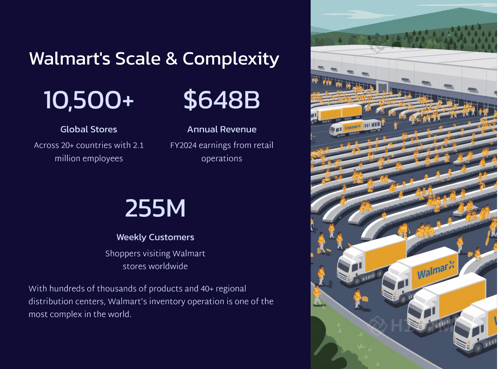

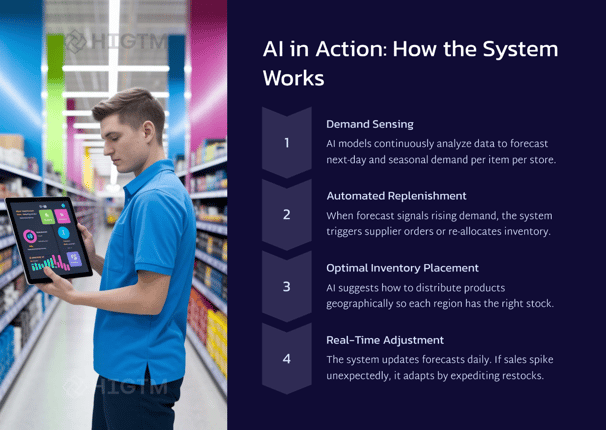

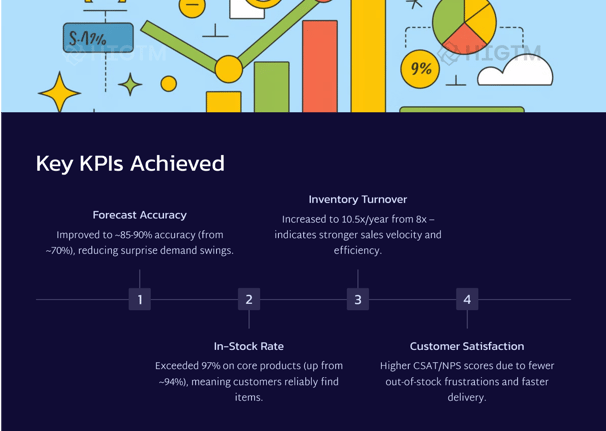

4. Data-Backed Results: Improvements Achieved
The true measure of any business initiative is in the results. In Walmart’s case, the AI-driven inventory optimization has delivered significant, quantifiable improvements. The following are some of the key data-backed results reported from Walmart’s inventory transformation:
Dramatic Reduction in Forecast Error: Walmart saw its forecasting accuracy improve substantially, with one source noting forecast errors reduced by about 30% after implementing AI. This means the demand predictions versus actual sales were much closer, on average, than before. Better forecasts set the stage for all other improvements because if you can predict more accurately, you can stock more efficiently.
20% Fewer Stockouts: One of the standout outcomes was a big drop in stockouts. Walmart was able to cut stockouts by roughly 20%thanks to more precise demand prediction and proactive restocking. In practice, this translates to many more customer visits ending in a purchase rather than a disappointment. A separate analysis showed Walmart’s stockout rate (the percentage of items out-of-stock at a given time) fell from about 5.5% to 3.0%. That seemingly small percentage difference is huge at Walmart’s scale – it means on any given day, there were far fewer empty shelf tags. Millions of potential “lost sales” were recaptured by ensuring products were available.
15% Reduction in Excess Inventory: On the flip side of stockouts, Walmart also attacked the problem of overstock and excess. The AI system’s balancing act yielded about a 15% reduction in excess inventory holdings. This implies that Walmart significantly trimmed the fat from its inventory. Products weren’t languishing unsold as long as before, and the need for clearance markdowns dropped. This not only saves cost but also improves Walmart’s inventory turnover (how fast inventory sells through). Indeed, a case study reported Walmart’s inventory turnover increased from 8.0 to 10.5 after these AI initiatives. To put that in perspective: at 8.0 turns, inventory sits on shelf an average of 45 days; at 10.5 turns, it’s more like 35 days. Faster turnover means fresher products, less risk of obsolescence, and freeing up of cash that would otherwise be tied in unsold stock.
Cost Savings in Supply Chain & Inventory Holding: By optimizing stock levels and reducing both overstock and understock situations, Walmart realized substantial cost savings. One analysis pegged supply chain cost savings at around $400 million annually – roughly a 20% reduction in inventory-related supply chain costs. These savings come from multiple areas: lower storage and handling costs (since excess stock was lower), fewer emergency shipments or last-minute re-routing (since stockouts were prevented more often), and less capital tied up (improving financial efficiency). Walmart effectively became leaner. Notably, industry research by McKinsey has found that companies leveraging AI in supply chains can reduce operational costs by up to 15%, so Walmart’s results are in line with (and even exceed) broader benchmarks.
Improved Delivery Speed and Order Fulfillment: Another benefit – somewhat unexpected on the surface – was faster fulfillment and delivery for customer orders. Because the AI helped position inventory in optimal locations and anticipate demand, Walmart could fulfill online orders or restock stores more quickly. A report highlighted that Walmart achieved a 25% improvement in delivery speed across its U.S. supply chain by using AI to optimize order fulfillment and routing. In practical terms, this supports faster home deliveries for customers and quicker replenishment for stores, especially in an omnichannel context (where a store might also ship out online orders). This improvement is crucial in the age of same-day and next-day delivery expectations. It also contributes to higher sales – a customer is more likely to order an item for delivery or pickup if they see it can arrive promptly from a nearby location.
Higher Customer Satisfaction & Sales Uplift: Walmart hasn’t publicly disclosed exact figures on sales increases attributable to AI, but it’s logical that fewer stockouts = more sales captured. Internal outcomes cited “better stock availability and happier customers” as a key result of the AI initiative. If shoppers find what they need, they’re more likely to return and to view Walmart as a reliable retailer. Some metrics, like customer satisfaction (CSAT) scores or Net Promoter Score (NPS), likely saw improvements due to more consistent in-stock levels. Moreover, by having the right products at the right time (especially for seasonal or trending items), Walmart could capitalize on demand surges rather than miss them. Overall, while the cost savings were clear, it’s safe to say Walmart also enjoyed a boost in top-line revenue growth driven by AI-enhanced inventory availability (even if the exact contribution is hard to isolate, it’s a factor in Walmart’s continued sales growth in recent years).
Example – Holiday Season Success: A good example of these improvements in action is the holiday season, traditionally the toughest test for inventory management. Walmart’s AI-driven approach was credited with making holiday 2022 and 2023 inventory flows the smoothest ever. By strategically positioning holiday merchandise across distribution centers and stores using AI predictions, Walmart ensured popular toys and gifts stayed in stock throughout the critical shopping weeks. This was a marked change from the past, where some hot toys might sell out company-wide unexpectedly. The AI not only predicted which items would be hits (using trends and even online search data) but also made sure they were at the right stores. The result was strong holiday sales with minimal stockouts, validating the system under peak stress conditions.
These results underscore the power of AI in a real-world, complex environment. Walmart’s scale magnified the impact – even small percentage improvements translate to big dollars – but the principles hold for retailers of many sizes. By the numbers, Walmart’s inventory optimization initiative hit the goals any retail executive would dream of: more sales captured (fewer stockouts), lower waste (less overstock), and operational savings, all at once.
To put it succinctly, AI turned Walmart’s inventory into a more precise, efficient machine. The company is better able to serve customers (which drives revenue and loyalty) while running leaner (which drives profitability). This dual win – boosting customer satisfaction and reducing costs – is the holy grail of retail operations, and Walmart appears to be achieving it with the help of advanced technology.
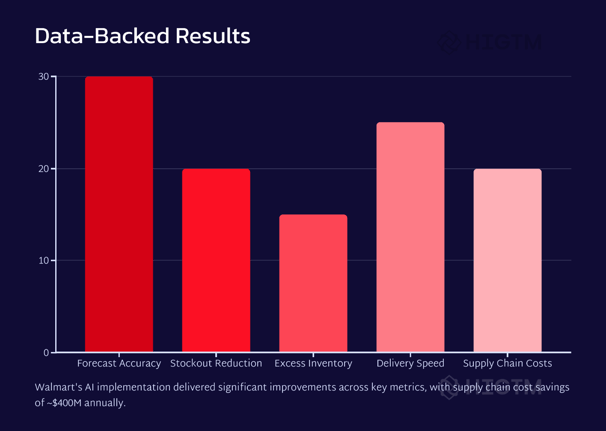

5. Key KPIs Demonstrating Success
It’s important to highlight the specific Key Performance Indicators (KPIs) that Walmart tracked to gauge the success of its AI-driven inventory optimization. These KPIs not only show where improvements occurred but also serve as a benchmark for other retailers aiming for similar initiatives. Here are the main KPIs and Walmart’s performance on each after the AI implementation:
Forecast Accuracy / Forecast Error: Definition: How close the demand forecasts are to actual sales, typically measured as a percentage error.
Walmart’s Outcome: Roughly 30% improvement in forecast accuracy was observed. If forecast accuracy was, say, 70% before, it moved closer to 90% accuracy for many products after AI. This KPI is fundamental because it influences all the downstream metrics. A 30% reduction in error meant Walmart could trust the AI numbers and plan inventory with confidence.
In-Stock Percentage / Stockout Rate: Definition: In-Stock % is the proportion of time products are available for sale; stockout rate is the complement (how often items are out-of-stock).
Walmart’s Outcome: In-Stock rates improved to around 97%+ on average, up from about 94% previously (these numbers derive from the stockout rate drop from 5.5% to 3.0%). This high availability is world-class for retail, ensuring customers can find items nearly every time they shop. Walmart likely tracked this KPI by category and by store as well, to ensure the improvement was broad-based.
Inventory Turnover: Definition: The number of times the company’s inventory is sold and replaced over a period (usually a year). Calculated as cost of goods sold divided by average inventory; higher turnover means more efficient use of inventory.
Walmart’s Outcome: Inventory turnover increased to ~10.5 times per year from a baseline of ~8.0. This jump in turns indicated that products were selling faster and inventory levels relative to sales had come down. It’s a critical efficiency and cash flow metric; Walmart improving it by ~31% is a strong sign of better inventory management. Many retailers struggle to push even one more turn out of their inventory – Walmart got 2.5 more turns through AI, which is significant.
Gross Margin Return on Inventory (GMROI): Definition: A ratio that measures the gross profit earned for every dollar of inventory held. (While we don’t have Walmart’s specific GMROI figures, an increase in turnover and better alignment of stock usually boosts GMROI).
Walmart’s Implication: With fewer markdowns and higher sell-through, Walmart’s GMROI likely improved. For instance, reducing excess stock by 15% means less margin lost to clearance sales, thereby improving the profitability of inventory. This KPI ties the inventory outcomes directly to financial performance.
Supply Chain Cost % of Sales: Definition: The proportion of sales revenue spent on supply chain activities (transport, distribution, holding costs).
Walmart’s Outcome: A 20% reduction in supply chain costs (about $0.4B saved on a $2B base) suggests this percentage of sales dropped significantly. Walmart freed up budget that either fell to the bottom line or was reinvested elsewhere (perhaps in further tech, or in price competitiveness). As a KPI, lowering the cost-to-serve while maintaining service levels is a big win.
Fulfillment Speed / On-Time Delivery: Definition: Measures how quickly and reliably customer orders are delivered, or how fast stores are restocked, often tracked as a cycle time or % on-time metric.
Walmart’s Outcome: With AI, Walmart achieved a 25% faster delivery speed in its supply chain. They likely measure things like days of supply in warehouses, store in-stock time, and e-commerce delivery times. Improving these means Walmart can promise quicker turnaround to customers (important for e-commerce and store pickup services) and better handle surges. It’s a KPI that ties directly to customer satisfaction and competitive positioning (especially versus Amazon’s logistics speed).
Customer Satisfaction / NPS (Net Promoter Score): Definition: Measures customer happiness and loyalty, often via surveys asking if customers found everything they needed or how likely they are to recommend the store.
Walmart’s Outcome: While exact figures are not public, Walmart’s leadership indicated that customer satisfaction improved as stockouts were reduced. It’s reasonable to assume metrics like “percentage of customers who found all items on their list” improved in surveys. A higher NPS might have been recorded post-implementation, as more customers see Walmart as a dependable one-stop shop.
Employee Efficiency Metrics: Definition: This could include metrics like hours spent on inventory management tasks, or productivity of inventory-related labor.
Walmart’s Outcome: By automating forecasting and using robots for scanning, Walmart likely reduced the labor hours spent on checking shelves and placing orders. Employees could be reallocated to customer-facing tasks. While we don’t have a number, Walmart probably tracked reductions in manual interventions (e.g., fewer emergency reorders, less time auditing inventory). This shows up indirectly in cost metrics but is worth noting as an operational KPI.
Each of these KPIs provides a lens on performance, and importantly, they are interrelated. For example, better forecast accuracy drives better in-stock rates, which drives higher sales and customer satisfaction. Improved turnover and lower costs drive better financial metrics. Walmart’s ability to hit targets on multiple KPIs demonstrates the holistic success of the AI initiative. It wasn’t just one metric that moved – the entire ecosystem of inventory metrics improved.
For other retailers reading this case, these KPIs serve as a checklist for what to monitor when implementing their own AI solutions. If you undertake an AI-driven inventory project, you’d want to see at least some of these metrics trending in the right direction: forecast accuracy up, stockouts down, turns up, costs down, etc., just as Walmart achieved.
6. Lessons Learned from Walmart’s AI Inventory Optimization
Walmart’s journey offers several lessons learned – insights into what worked, what challenges were encountered, and how they were overcome. These lessons can guide other organizations as they implement AI in operations:
Start with a Strong Data Foundation: A clear lesson is that AI is only as good as the data feeding it. Walmart had to invest in consolidating data from various sources (sales, inventory, supplier, online, etc.) into unified platforms. Early on, they identified data quality issues – for example, inventory records that might be off due to theft or scanning errors, which Target’s team also noted as a problem to solve with AI. Cleaning up data and ensuring accuracy was a crucial precursor to reliable AI outcomes. Retailers must often integrate legacy systems and ensure consistent data definitions (e.g., what constitutes “in stock”). Walmart’s use of a cloud-based data lake and real-time data streams is a blueprint: get your data house in order first.
Pilot, Learn, and Scale: Walmart didn’t flip the switch everywhere at once. They piloted AI models in limited settings, perhaps one product category or one region, to test and refine. This iterative approach allowed them to learn what features in the models drove accuracy and which didn’t, and to gauge how managers interacted with the AI suggestions. Only after proving value did they scale it across all stores. This mitigated risk and built confidence. The lesson: treat AI implementation as a learning journey – start with a manageable scope, nail it, then expand. By the time it was enterprise-wide, Walmart’s models had been battle-tested.
Combine Human Expertise with AI – Change Management is Critical: One of the smartest moves Walmart made was keeping their people in the loop and even giving them final say. They branded the approach as “people-led and tech-powered”.
Walmart’s experienced merchandising and supply chain professionals carry decades of tacit knowledge – the AI was designed to augment, not replace, that knowledge. In practice, when the AI flagged a need to reorder a product, it was presented as a recommendation to planners/buyers, who could adjust quantities based on factors the AI might not know (like an upcoming local promotion or a last-minute supplier issue). Over time, as the AI proved its accuracy, planners increasingly trusted its outputs and in fact many manual decisions became automatic. But importantly, Walmart spent a lot of effort on change management: communicating the purpose of the AI tools, training employees on how to use and interpret them, and even adjusting KPIs for staff to align with the new processes. For example, store managers might be evaluated on maintaining in-stock levels with the help of AI rather than purely on manual ordering metrics. By bringing employees along, Walmart avoided the resistance or fear that often hampers AI projects in organizations.
Address Edge Cases (Anomaly Handling): The introduction of the “anomaly forgetting” capability was a direct lesson learned from early model training. If the first version of the model naïvely took every historical spike as gospel, it would make mistakes. Walmart’s team realized they needed to distinguish normal patterns from outliers and adjust accordingly. This is a lesson in model refinement: often the first results from AI will need tuning. One must analyze errors (e.g., where forecasts were still wrong) and identify why. Walmart found that excluding one-off events from the training data or adjusting the model’s sensitivity improved outcomes. Retailers should expect an iterative tuning phase where the AI is calibrated to handle real-world messiness.
Infrastructure and Scalability Matter: Another behind-the-scenes lesson is the importance of having the IT infrastructure to support AI at scale. Walmart’s AI has to process data for 4,700+ U.S. stores and beyond, in real time. They likely encountered challenges in computing power and needed to leverage cloud computing (Walmart has partnerships with Microsoft Azure for cloud services, for example). They built systems that could run complex models and deliver decisions fast (no point having a great model that takes 2 days to output results – by then the data is stale). The lesson: ensure your tech stack (cloud platforms, databases, networks) can handle large-scale AI workloads. Scalability and speed are as important as the model’s logic.
Measure and Communicate Success: Walmart clearly defined the metrics that mattered (the KPIs we discussed) and measured them throughout the rollout. By doing so, they could communicate wins: e.g., telling store ops teams “hey, we saw 20% fewer stockouts after implementing this new system”, or telling leadership “inventory turnover improved and freed $X in cash.” This created positive reinforcement to continue the project and invest further. Any retailer doing this should set up a baseline measurement period and then track improvements diligently. Celebrating quick wins (like a successful holiday season managed by AI) helps maintain organizational buy-in.
Remain Customer-Centric: Even though this is a story about AI and back-end operations, Walmart kept the customer benefit in focus – “seamless and gratifying shopping experiences” as they called it. This mindset ensured the project’s goals aligned with business goals (better customer service, which drives sales). A lesson is not to implement AI just for cool tech’s sake, but to tie it to end-customer value. Walmart did so by framing it as “the customer finds what they need at low cost” which is Walmart’s core mission. This clarity of purpose likely helped steer the implementation in the right direction (e.g., focusing on stockouts first because that directly hits customer satisfaction).
Prepare for Cultural Shift: Lastly, Walmart’s embrace of AI signaled a cultural shift to a more tech-driven retailer. They learned that continuous innovation must be part of the culture. They even set up an AI Center of Excellence to share best practices internally and invested in ongoing training (the numbers of employees trained in AI each year kept rising). The lesson: a one-time implementation isn’t enough; it’s about building long-term capabilities. Companies should cultivate internal champions and educate their workforce to sustain the AI systems after the consultants leave or the initial project ends.
Walmart’s lessons learned highlight that technology implementation is as much about people and process as algorithms and data. Any retailer aiming to replicate this success should heed both the technical and organizational aspects Walmart navigated.
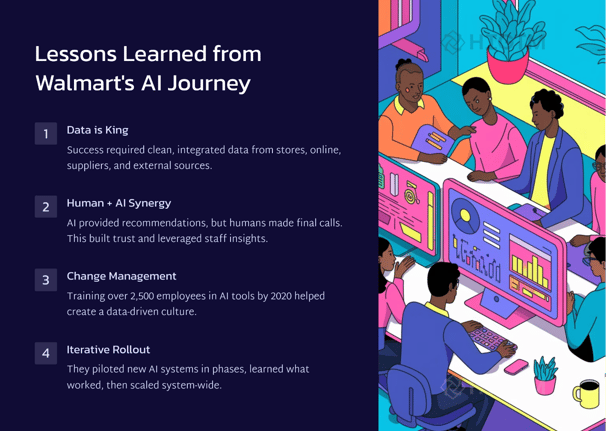

7. Strategic Takeaways and How Other Retailers Can Replicate Success
From a management consultant’s perspective, Walmart’s case offers strategic takeaways for other retailers looking to optimize inventory with AI:
AI-Driven Inventory is a Competitive Imperative: The retail sector is seeing AI-based forecasting and inventory optimization rapidly becoming the norm for leaders. As noted in a Virtasant analysis, retailers that failed to adapt (like Sears or Toys “R” Us) struggled partly due to poor inventory management and lack of modern analytics. Meanwhile, those who embrace AI are reaping rewards. The takeaway: adopting AI for inventory isn’t just operational improvement, it’s defending your market position. It can be the difference between customers choosing you or a competitor. Retail executives should treat this as a strategic priority, not just an IT project.
Leverage Both Off-the-Shelf Solutions and Custom Modeling: Not every retailer has Walmart’s resources to develop AI from scratch – but the good news is the ecosystem of AI tools is rich. There are enterprise solutions like Blue Yonder, SAP AI, Oracle SCM Cloud that come with sophisticated forecasting and optimization algorithms built-in. Cloud providers like Amazon Web Services (AWS) (with Amazon Forecast and related AI services), Microsoft Azure, and Google Cloud AI offer services that retailers can use without building everything internally. The key is to choose tools that integrate well with your data and operations. Walmart combined external tools (like Blue Yonder for supply chain) with proprietary models – other retailers can do similarly based on needs. Essentially, don’t reinvent the wheel if you don’t have to. Get a platform that fits, then customize the last mile. The fastest way to replicate Walmart’s success is to stand on the shoulders of these AI solution giants, then fine-tune for your specific context.
Invest in Data Integration and Quality: We can’t emphasize this enough: integrated, clean data is the bedrock of any AI initiative. Retailers should invest in modernizing their data infrastructure – this might mean moving to a cloud data warehouse, implementing data cleaning tools, and establishing master data management for products and locations. Break down silos between ecommerce and store data; ensure inventory records are accurate (possibly using IoT sensors or regular audits). This step is often the most time-consuming, but it yields benefits beyond AI too (better reporting, visibility, etc.). Without a single source of truth for inventory and sales, AI results will be subpar.
Focus on High-Impact Areas First: Start where AI can deliver a clear win. For example, a mid-sized retailer might begin with demand forecasting for its top 1000 SKUs, or for the most seasonal items, or to solve a known problem like “we keep running out of stock on weekends.” By focusing on a segment with high impact, the project can quickly show ROI. Walmart tackled holidays and key products to prove out the system. Others might start with a particular category (e.g., fresh produce, which has high waste – AI can be used to reduce spoilage by better matching supply to true demand). The lesson is to narrow scope initially for a manageable implementation and measurable outcome. Success in one area can justify expanding to others.
Define Clear KPIs and Track Them: Use the KPIs discussed (forecast error, stockouts, turnover, etc.) as guiding metrics. Set targets like “reduce stockouts to <2%” or “improve inventory turns by 20% in one year”. This not only gives the project a goal but also aligns the team on what success looks like. Retailers should put in place a dashboard (many AI tools will have one) that continuously monitors these KPIs. Having tangible numbers to hit helps secure executive buy-in and cross-functional alignment (e.g., merchandisers, supply chain managers, store ops all work together when they share a common goal like in-stock%).
Engage Cross-Functional Teams: Inventory optimization sits at the intersection of merchandising, supply chain, store operations, and IT. Walmart’s success was partly due to how these teams collaborated under a unified strategy. Other retailers should form a cross-functional task force for their AI initiative – perhaps led by a chief data officer or operations head – including buyers, planners, warehouse managers, and IT data scientists. This ensures the solution considers all angles (for example, the model might say “ship this product from DC A to store B”, but the logistics person needs to input transport constraints, etc.). Cross-functional engagement also aids in change management since each department feels ownership.
Train and Upskill Staff: A strategic takeaway is that you must invest in people, not just technology. Budget for training programs to improve data literacy and to teach staff how to work with AI outputs. This might involve workshops on interpreting forecast confidence intervals or using new dashboard tools. Building an internal “AI culture” will make the changes stick. Walmart ramped up training significantly over its AI rollout period, demonstrating commitment to its workforce. For other retailers, empowering your team to use AI effectively can multiply the value of the tech.
Consider Phased Rollout and Iteration: Plan the implementation in phases – perhaps proof-of-concept, pilot, phased rollout, and full deployment. At each stage, perform retrospectives. Ask: did the forecast accuracy improve as expected? If not, why? Iterate on the model or process before scaling further. This phased approach reduces risk and ensures the final product is robust. It also helps in budgeting and resource allocation, as you can allocate more as confidence grows. For example, start with one region’s distribution center network; if that works, expand nationwide.
Utilize Expert Help and Partnerships: Not every retailer has a huge internal data science team. It’s wise to engage consultants or solution partners (like HI-GTM or technology vendors’ professional services) who have done this before. They can accelerate the project, avoid pitfalls, and train your people. Walmart partnered with tech companies (Microsoft, and various AI startups) to stay at the cutting edge. Smaller retailers can similarly partner or even outsource initial model development, then bring it in-house. The key is to build capability, not dependency – use experts to jump-start, but make sure your team learns along the way to eventually own the system.
Monitor and Adapt Continuously: The retail world is not static. Customer behavior shifts, new data sources emerge (e.g., social media sentiment might become a useful predictor), and competitors’ moves change the game. A strategic plan should include ongoing model maintenance. After the initial win, continue to refresh the models, perhaps incorporate new AI techniques (like newer algorithms or even AI to optimize pricing in tandem with inventory). Walmart, for instance, keeps evolving its AI – including now using generative AI for search and other aspects. So think of AI inventory optimization not as a one-time project, but as a new way of working that will be continually refined.
Ethical and Trustworthy AI Use: Another modern consideration – ensure the AI is fair and ethical. In inventory context, this might mean ensuring the model doesn’t inadvertently disadvantage certain stores or regions (e.g., always shorting rural stores to feed urban demand). While not a prominent issue in this case, it’s part of AI governance to monitor. Walmart’s AI ethics focus likely addressed things like not reinforcing biases and being transparent about decisions. Retailers should similarly govern their AI to maintain trust with employees and communities.
In essence, other retailers can replicate Walmart’s success by treating AI-driven inventory optimization as a strategic, organization-wide transformation, not just a tech upgrade. It requires leadership commitment, the right tools, proper data, staff engagement, and a phased plan. The payoff, however, is well worth it – as seen in Walmart’s case of improved efficiency, cost savings, and stronger customer loyalty.
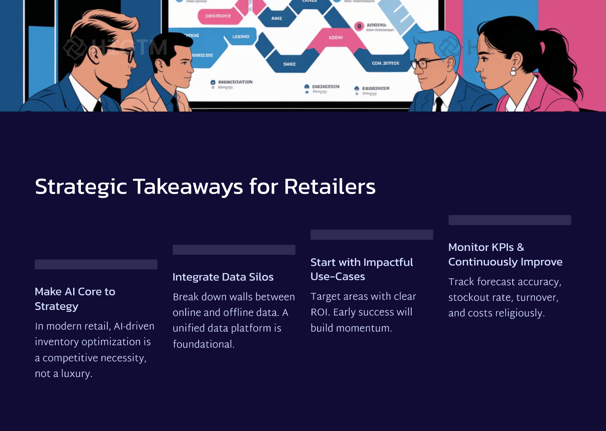

8. Conclusion: The New Era of AI-Optimized Inventory
Walmart’s real-world case study vividly illustrates the potential of AI in transforming retail inventory management. The company moved from a traditional approach that had cracks – stock imbalances and reactive fixes – to a modern, AI-augmented system that is predictive, proactive, and highly efficient. The journey wasn’t just about installing new software; it was a comprehensive change in technology, process, and culture. By leveraging advanced machine learning and analytics, Walmart achieved what every retailer strives for: the right products in the right place at the right time, with minimal waste.
The results speak loudly: significant reductions in stockouts and overstock, improved turnover and cost savings, and a better experience for customers. KPIs across the board improved. It’s a testament to how data and AI can unlock improvements even in a company as optimized as Walmart, suggesting that virtually any retailer can find value in these techniques.
For the retail industry at large, Walmart’s success is both a blueprint and a wake-up call. AI-driven inventory management is becoming a competitive necessity. Consumers today have little patience for out-of-stock messages or slow deliveries; they gravitate towards retailers who consistently meet their needs. AI is a key enabler of that level of service. Retailers who invest smartly in these systems stand to gain agility and insights that were never possible before, while those who delay risk falling behind in customer satisfaction and operational efficiency.
In practical terms, the case also demonstrates that you don’t have to be a tech giant to use AI – the tools and know-how are increasingly accessible. What it does require is a clear strategy, executive support, and a willingness to evolve old processes. The lessons from Walmart – about data readiness, phased implementation, human-AI collaboration, and continuous improvement – provide a valuable guide.
As we move into the future, we can expect AI to play an even deeper role in retail supply chains: from instant demand sensing to automated store replenishments via drones or robots, to AI negotiating with suppliers for best terms. Walmart is already experimenting in some of these next-frontier areas. But the foundation remains a solid demand forecast and inventory plan, which is what they have built.
For any retail CEO or supply chain VP reading this, the takeaway is clear: the era of AI-optimized inventory is here, and the question is not “should we do it?” but “how fast can we adopt?”. Walmart’s story shows that with the right approach, the rewards are substantial. Retailers of any size can start on this path – perhaps not with the same scale, but with the same principles – and transform their own inventory management from a perpetual headache into a source of strategic advantage.
By learning from Walmart’s example and tailoring these insights to their own operations, other companies can move toward a future where stockouts and overstocks become rarities, where each decision is backed by data, and where the supply chain is intelligent, agile, and aligned with the ever-changing demands of customers. In retail, that’s the recipe for success – and now AI is a key ingredient.
Sources: This case study was informed by credible reports and data, including Walmart’s own disclosures and third-party analyses. Key references include Walmart’s tech blog, industry case studies, and expert commentary on AI in retail, all of which corroborate the improvements and strategies discussed. These sources underscore the validity of the results and provide additional context for readers interested in the technical and managerial details of Walmart’s AI transformation.
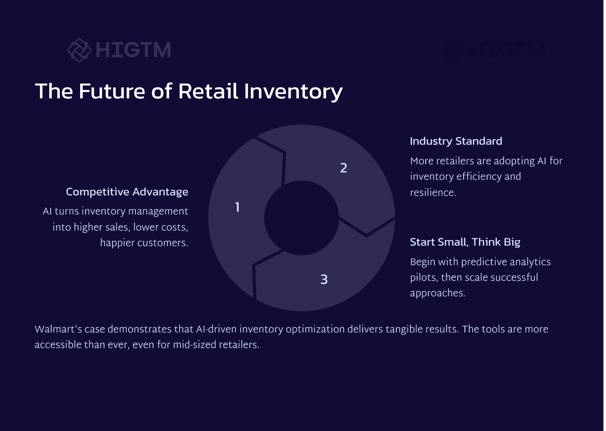

Turn AI into ROI — Win Faster with HIGTM.
Consult with us to discuss how to manage and grow your business operations with AI.
© 2025 HIGTM. All rights reserved.
